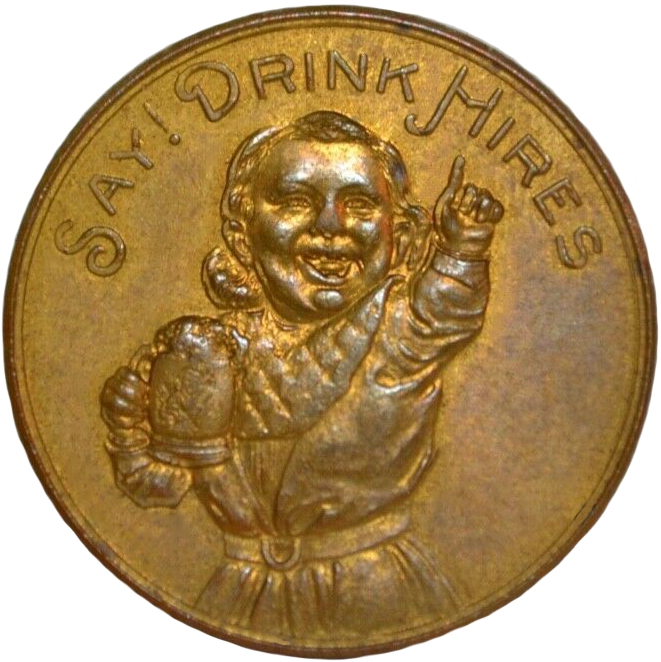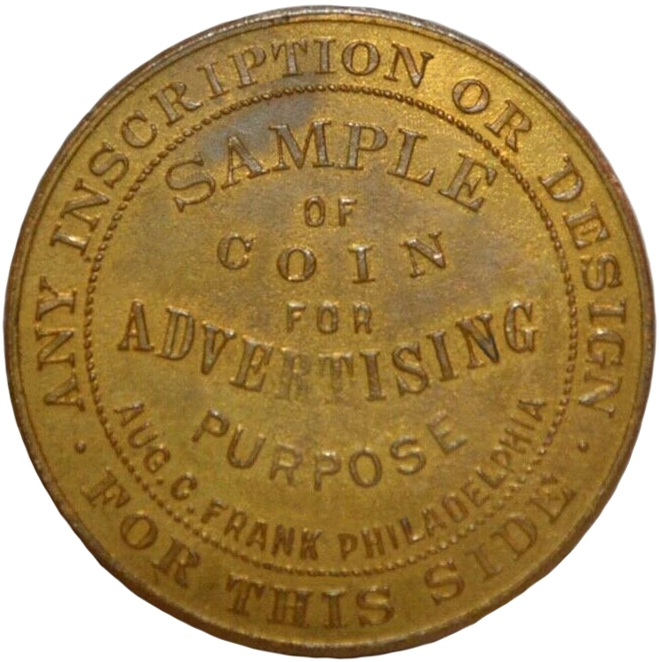1906
IT HAPPENED IN…1906
An earthquake devastated San Francisco,
California April 18, 1906.
Most of the damage was caused by the ensuing fire that burned
for three days.
The Pure Food and Drug Act of 1906 prohibited the
sale of adulterated foods and drugs, and required full disclosure of
contents via product package labeling.
Twenty one people, including 18 blacks, died
during race riots in Atlanta, Georgia.
The first radio broadcast of voice and music was
made by a private radio experimenter.
Upton Sinclair’s novel,
The Jungle, exposed the
truth about the Chicago meat-packing industry, hardships imposed on
workers, and the sale of questionable and tainted meat.
Devil’s Tower in Wyoming was designated the first
U.S. national monument.
Planters Peanuts were introduced.
Newly introduced soft drinks included Buffalo
Rock Ginger Ale and Barq’s Root Beer.
While Hires focused on fountain sales and marketing
Munimaker dispensers, the Coca-Cola Company was busy attracting and
licensing franchisee bottlers. Per
the National Bottlers' Gazette, in early 1906 the
Coca-Cola Company notified their bottlers:
Sales of Coca-Cola in Bottles.
Over one hundred Bottling Plants began business
during the year 1905. The
record they have made is very interesting.
The largest sales for one of these new plants were made by The
Coca-Cola Bottling Company, Salisbury, N.C.
They purchased 3092 Gallons Coca-Cola Syrup and this would
produce 395,776 Bottles of Carbonated Coca-Cola.
The receipts from sale of same at 5 cents per bottle would amount
to $19,788.80.
Success like this can be obtained by most any
Bottling Establishment when the right kind of efforts are made.
The principal difficulty is found in the disposition of the first
three or four hundred gallons.
When you have disposed to good advantage of the product of five
hundred gallons of Coca-Cola syrup, your final success is assured.
Look at the record of the branches that have been established for
several years. See how they
grow. Memphis, Birmingham,
Rome, Columbia, Albany, Lexington, Pittsburg and St. Louis show a gain
of nearly 100% over 1904 while in smaller and newer places there has
been a gain of 300% to 400%.
It is of first importance that the management have an abundance
of courage and confidence; then see that the matter is intelligently and
properly presented to the small dealers who are handling your goods.
If enthusiasm can be created and maintained all along the line,
your opportunities for doing an enormous business are almost unlimited.
Do not fail to make judicious use of all the advertising matter
you receive. Good signs are
not of much value in your office, but will do a vast amount of good when
properly put up on buildings occupied by your customers.
Early on the Coca-Cola Company realized the
tremendous sales potential offered via franchising the manufacturing and
distribution of soft drinks.
Franchising in combination with a powerful advertising program
lead to Coca-Cola’s tremendous growth rate and ultimate success.
Their marketing approach offered bottlers a quality product, a
trademarked name, an exclusive territory, price discounts on bottles and
crown caps, and point-of-sale advertising materials.
The G. A Duerler Manufacturing Company, a long-time San Antonio, Texas soda bottler, ran these San Antonio newspaper advertisements during 1906:
(Figure 1906-01, G. A Duerler
Manufacturing Company newspaper advertisements)
November 4, 1905 the Charles E. Hires Company filed a
request with the United States Patent Office to trade mark the word
“Hires.” The request read:
THE CHARLES E. HIRES COMPANY, OF
PHILADELPHIA, PENNSYLVANIA
TRADE MARK FOR ROOT-BEER, ROOT-BEER EXTRACT, AND THE
DRY INGREDIENTS FOR MAKING ROOT-BEER.
To all whom it may concern:
Be it known that THE CHARLES E. HIRES COMPANY, a
corporation organized under the laws of the State of Pennsylvania, and
located in the city of Philadelphia, in said State, doing business at
Nos. 210, 212, and 214 North Broad street, in said city of Philadelphia,
has adopted for its use a trade mark of which the following is a
description.
The trade mark of said corporation consists of the
word “HIRES.” This trade
mark has been continuously used in the business of said corporation and
that of its predecessor Charles E. Hires since about August 1, 1877.
The class of merchandise to which the trade mark is appropriated is miscellaneous, and the particular description of goods comprised in said class upon which the said trade mark is used is root beer, root beer extract, and the dry ingredients used in making root beer.
The trade mark is equally displayed on the packages
containing the goods by placing thereon a printed label on which the
same is shown. It is also
blown in the bottles containing the root beer and root beer extract, and
displayed on the sealing caps of the root beer bottles.
THE CHARLES E. HIRES COMPANY
(signed) CHARLES E. HIRES, President
The United States Patent Office approved and
registered Hires’ trade mark June 26, 1906.
The trade mark was assigned No. 54,465.
The Hires trade mark was renewed August 10, 1961 by Procter &
Gamble, with "the dry ingredients used in making root beer” wording
deleted. A third renewal
was approved for Beverages International, Inc. during their years of
Hires ownership.
PURE FOOD AND DRUGS ACT OF 1906
June 30, 1906 President Roosevelt signed the Pure Food and Drugs Act of
1906 into law effective January 1, 1907.
The Act was aimed at “preventing
the manufacture, sale, or transportation of adulterated or misbranded or
poisonous or deleterious foods, drugs, medicines, and liquors, and for
regulating traffic therein.”
As Dr. Harvey W. Wiley, chief chemist at the Department of
Agriculture, stated: “Tell the truth on the label and let the consumer
judge for himself.”
The following excerpts are from
the Act:
The term 'drug,' as used in this Act, shall include all medicines and preparations recognized in the United States Pharmacopoeia or National Formulary for internal or external use, and any substance or mixture of substances intended to be used for the cure, mitigation, or prevention of disease of either man or other animals. The term 'food,' as used herein, shall include all articles used for food, drink, confectionery, or condiment by man or other animals, whether simple, mixed, or compound…
The term, 'misbranded,' as used herein, shall apply
to all drugs, or articles of food, or articles which enter into the
composition of food, the package or label of which shall bear any
statement, design, or device regarding such article, or the ingredients
or substances contained therein which shall be false or misleading in
any particular, and to any food or drug product which is falsely branded
as to the State, Territory, or country in which it is manufactured or
produced.
The Pure Food and Drugs Act of 1906 had a
significant impact on the soft
drink industry. Manufacturers and bottlers were required to
fully identify the contents of their products, not deceive or mislead
consumers by adding ingredients such as cocaine or other drugs, and
bottles and/or labeling had to identify a bottle’s capacity.
Hires immediately began implementing the labeling changes needed
to comply with the Act.
Considerable information concerning this landmark legislation is
available. One excellent
source is “The Story of the Laws Behind The Labels, Part I: 1906 Food
and Drugs Act” by Wallace F. Janssen, FDA historian (http://www.cfsan.fda.gov/~lrd/history1.html).
Another very entertaining source is “Who put the borax in Dr.
Wiley’s butter,” an article authored by Gerald Carson for the August,
1956 issue of American Heritage
magazine.
The shoulders of this bottle are embossed on both
sides: Hires – TRADE MARK REGISTERED – 10 FL. OZ. NET.
Paper labels were affixed to provide the required information
about the bottle’s contents.
(Figure 1906-02, blue aqua crown top bottle,
9.5” tall)
This dovetailed, wooden shipping case held one dozen
packages containing bottles of Hires Root Beer Extract.
Not missing an advertising opportunity, Hires glued a 5.0” x 7.0”
cardboard notice to the back of the case stating:
It is
an acknowledged fact that the Beer made from these Packages is superior
to anything of the kind ever offered to the public.
It is made from fresh Roots and Barks, and will be found
refreshing and appetizing.
This Beer has attained a high reputation for purity and delicacy of
flavor possessed by no other, and is not only a healthy temperance
beverage, but one of the most pleasant and invigorating that can be
found for use in warm weather, producing a gentle stimulation throughout
the body without the deleterious effects of a momentary excitement.
The low price for which it is offered, the readiness with which
the Beer is prepared from it, its healthiness and agreeableness as an
every-day drink, have rendered it one of the most popular articles in
the market.
(Figure 1906-03, wooden
shipping case, 5.5” high, 5.5” deep, 7.5” wide)
Five gallon metal containers of Hires fountain syrup were shipped in
wooden crates. This example
is stamped “GUARANTEED BY THE CHAS. E. HIRES COMPANY UNDER THE FOOD AND
DRUGS ACT JUNE 30, 1906 SERIAL NO. 127” above the word Hires on the
front.
(Figure 1906-04, wooden Hires
Fountain Syrup crate, 17.0” x 11.0”)
Cardboard tags were attached to one gallon containers of Hires syrup. The back contains licensing information, plus fountain and Munimaker dispensing directions. Note the reference to the Pure Food and Drugs Act of 1906, and the limitation “that this syrup shall not be used for bottling purposes.”
(Figure 1906.05, Hires Syrup cardboard tag, front, 4.75” x 2.25”)
(Figure 1906.05, Hires Syrup cardboard tag, back, 4.75” x 2.25”)
Hires implemented several labeling changes as a result of the Pure Food and Drugs Act of 1906. A major change was the renaming of Hires’ Cough Cure as “Hires’ Cough Remedy.” The package labeling was also revised to specify “2 MINIMS CHLOROFORM IN EACH FLUID OUNCE – FROM BALSAM, ROOTS, AND BARKS. PERFECTLY PURE. - No Opium, or other poisonous drugs in any form. Guaranteed under the Food and Drugs Act, June 30, 1906.”
(Figure 1906-06, Hires’ Cough
Remedy package)
At the same time, Hires Root Beer underwent a major
revision, with the product name officially changed from “Hires’ Improved
Root Beer” to simply “Hires.”
The packages were revised to read “This is the same Article
formerly put up under the name of HIRES’ IMPROVED ROOT BEER! – Hires
stands for Rootbeer and is registered in the U.S. Patent Office as
such.”
(Figure 1906-07, Hires
package)
Here are the four sides of an aqua Hires Rootbeer
extract bottle:
(Figure 1906-08, Hires
Rootbeer extract bottle, four side views)
In 1906 Hires contracted with Villeroy & Boch, a major Mettlach, Germany manufacturer of premium porcelain and ceramic products, to produce several items. This Hires Boy stein is 4.25” high with a 2.125” diameter base. The bases of these steins are stamped “MADE IN GERMANY – VILLEROY & BOCH – FOR THE CHARLES E. HIRES COMPANY,” with either “06” or “07” incisions indicating the manufacturing year. Delivery of steins in 1906 didn’t go well and Hires subsequently announced “delivery complaints (were) to be fixed in 1907.”
(Figure 1906-09, Villeroy & Boch stein, front)
(Figure
1906-09, Villeroy & Boch stein, base, manufactured in 1907)
Villeroy & Boch also produced beautiful ceramic syrup dispensers with
varying trim colors of blue-gray, green, and brownish-gold.
They are each 19.0” tall.
(Figure 1906-10, ceramic syrup
dispenser, blue-gray, left side)
(Figure 1906-10, ceramic syrup
dispenser, blue-gray, right side)
(Figure 1906-11, ceramic syrup
dispenser, green, left side)
(Figure 1906-12, ceramic syrup
dispenser, brownish-gold, left side)
This base of this very rare, bulbous, ceramic mug
with a poem is stamped “MADE IN GERMANY – VILLEROY & BOCH – FOR THE
CHARLES E. HIRES COMPANY.”
(Figure 1906-13, bulbous,
ceramic mug, 4.25” high, 2.5” base diameter)
Schorndorfer & Eberhard Company, a Cleveland, Ohio
industry supply house, advertised the new Hires kegs and Hires
Innovation jar dispensers in their 1906 catalog.
(Figure 1906-14, Schorndorfer
& Eberhard Company catalog page)
This 4.0” x 5.0” photograph shows two individuals seated in rocking chairs who were most likely Hires salesmen. The man on the left has a Villeroy & Boch Hires Boy stein, while the man on the right is holding a salesman’s sample Hires keg.
(Figure 1906-15, photograph)
(Figure 1906-16, Hires Innovation Jar, Hires
Family Archives)
(Figure 1906-17, wooden salesman’s sample
Hires keg, 12.0” tall)
The front of this two-sided card lists and
illustrates the major parts of a Hires keg:
(Figure 1906-18, Hires Keg
Parts List and Instruction Card, front)
The back of the card continues the parts list and illustrations, and also provides detailed instructions on setting up and operating a Hires keg:
(Figure 1906-18, Hires Keg
Parts List and Instruction Card, back)
This metal letter opener features a Hires keg image and reads “DRINK HIRES ROOT BEER” on one side of the handle. The Hires Boy and “HIRES TO YOUR HEALTH FOREVER” is on the opposite side of the handle. The blade is marked D. PERES - SOLINGEN – GERMANY. Solingen, the “City of Blades,” is known internationally for the manufacturing of high quality swords, knives, scissors, razors, etc.
(Figure 1906-19, letter opener
D. Peres also manufactured pocket knives for Hires. The sides of this two-bladed example match the handle of the letter opener. One side of the larger blade bears a small barrel image and is marked D. PERES - SOLINGEN - GERMANY, while the reverse side is marked MAGNETIC - CUTLERY Co - PHILA. PA. One side of the smaller blade also bears the small barrel image. The knife measures 2.75" long closed, and 5.75" long with both blades fully extended.
(Figure 1906-20, pocket knife)
Both blades of this 2.875" long, double-bladed, pocket knife with brass handles are marked T. HESSENBRUCH & Co. GERMANY.
(Figure 1906-21, pocket knife front, closed)
(Figure 1906-21, pocket knife back, open)
The Gustave Fox Company of Cincinnati, Ohio
manufactured this metal pencil clip for Hires. It reads “DON’T FORGET Hires”
(Figure 1906-22, pencil clip, front and back)
(Figure 1906-22, pencil clip as attached)
This sample advertising coin picturing the Hires Boy holding a stein was struck by August Conrad Frank, a noted Philadelphia engraver. The pictured example appears to be original, although it is possibly a re-issue or a reproduction.
(Figure 1906-23, sample advertising coin,
probably brass, 1.0" diameter)


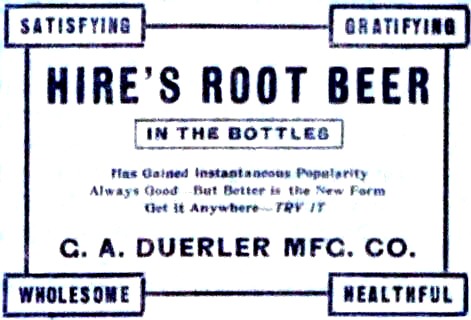
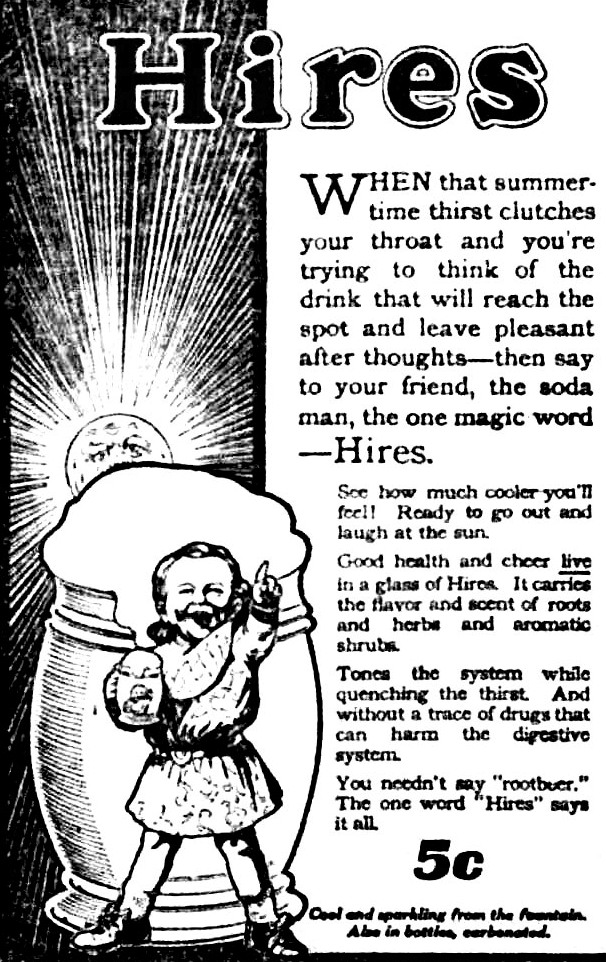

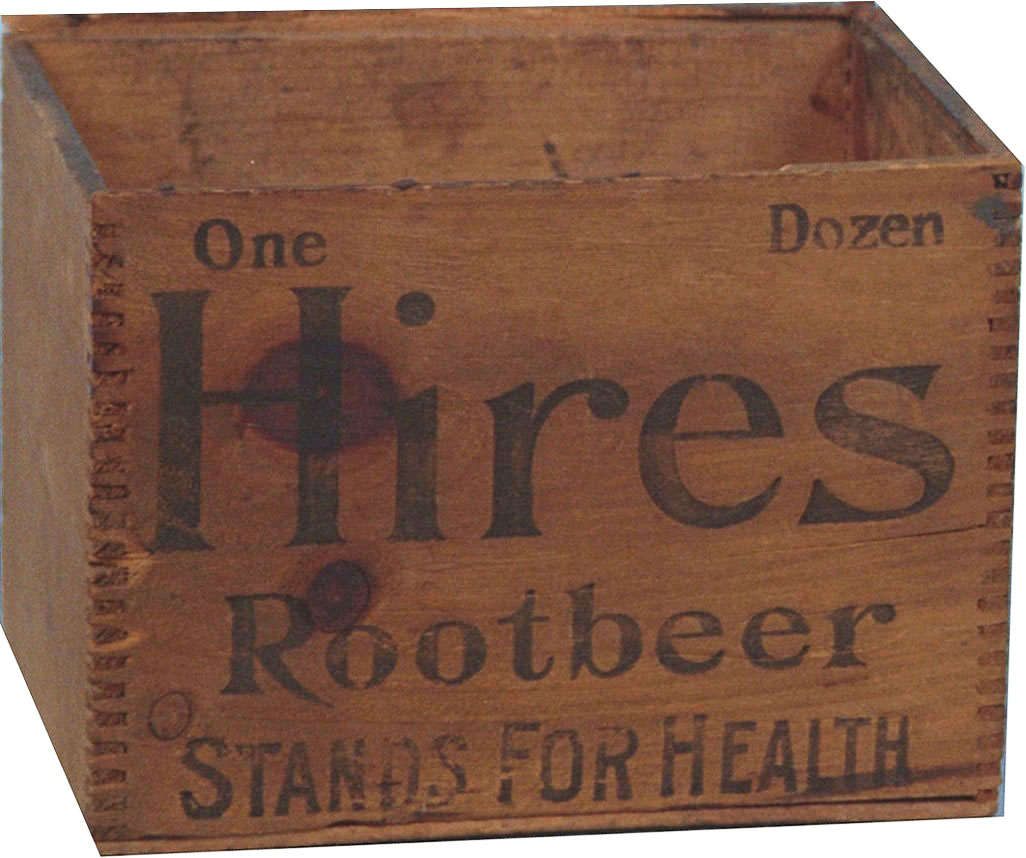
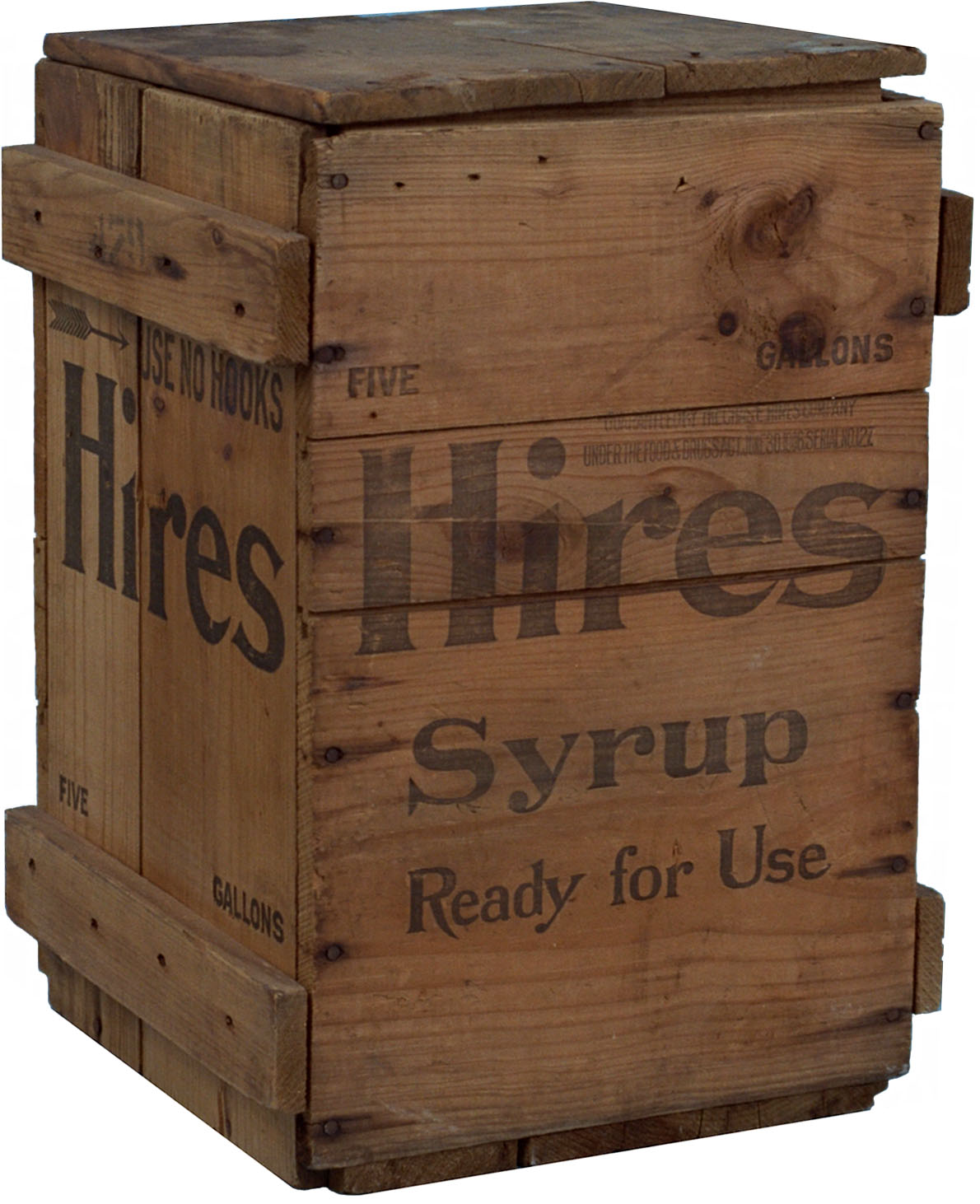
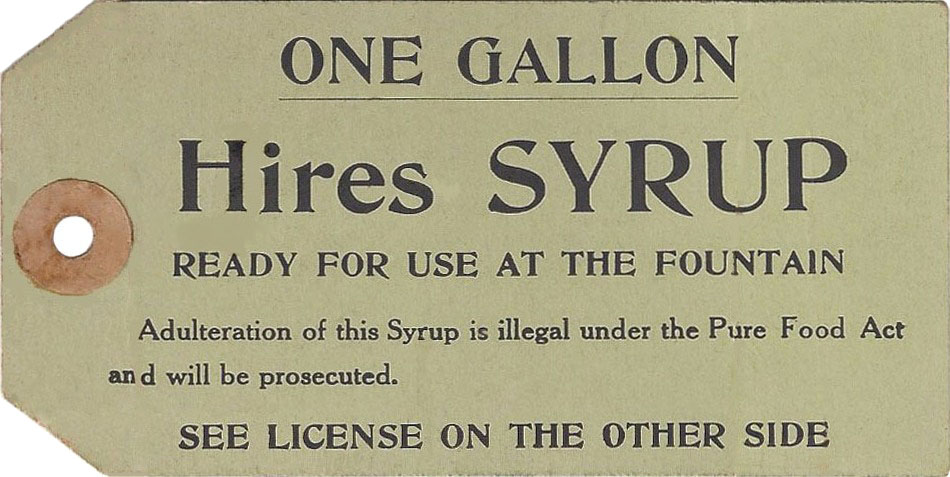
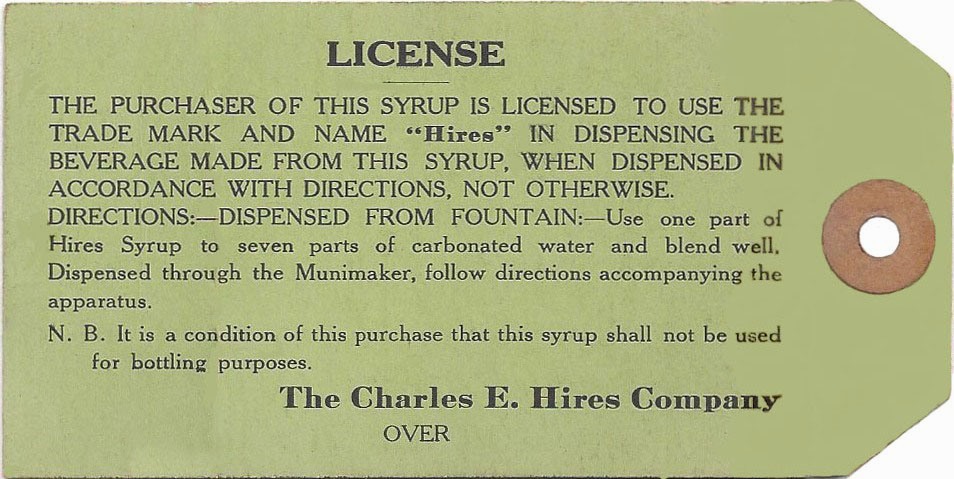
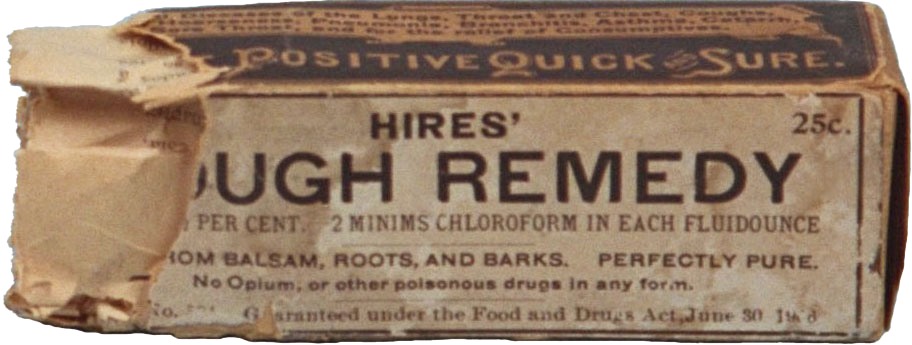
%20Improved%20Root%20Beer%20concentrate.jpg)


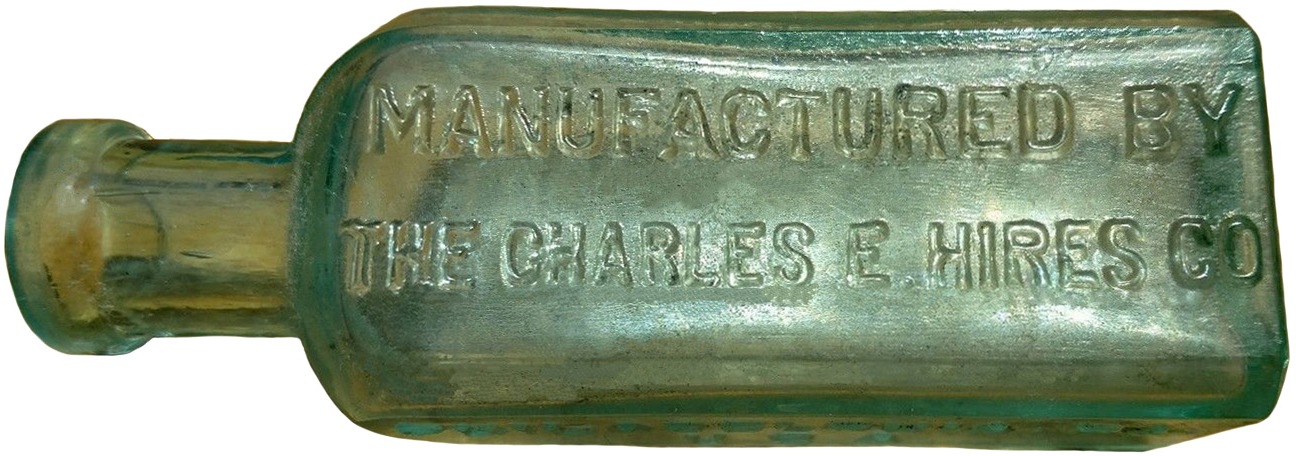
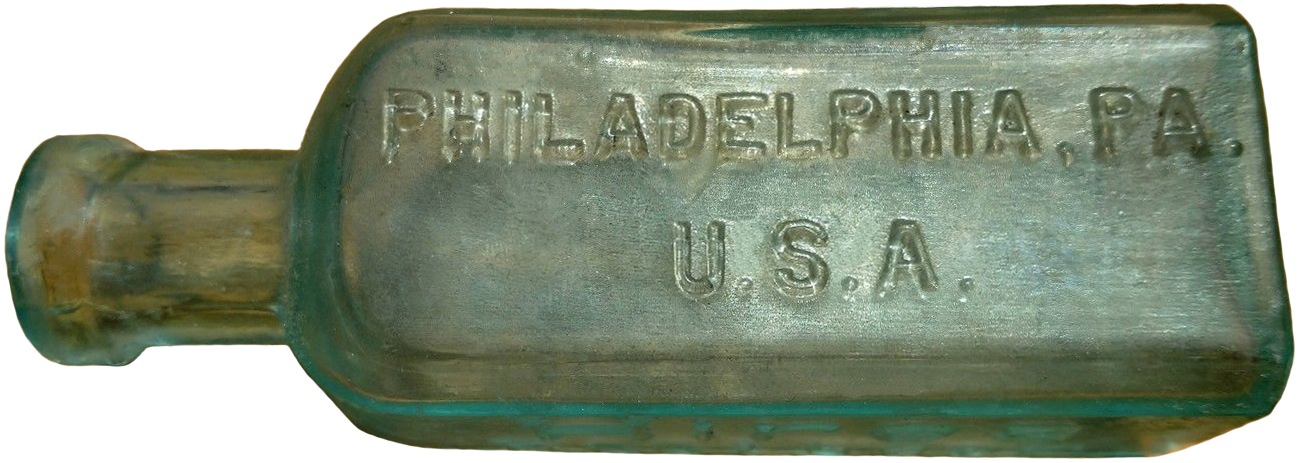
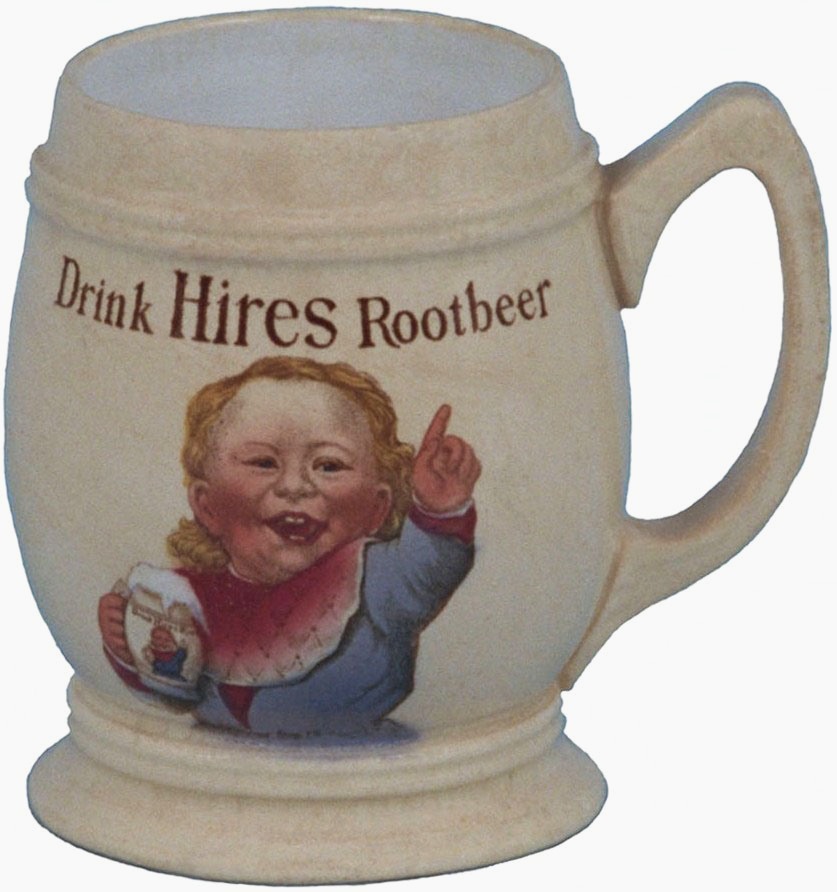
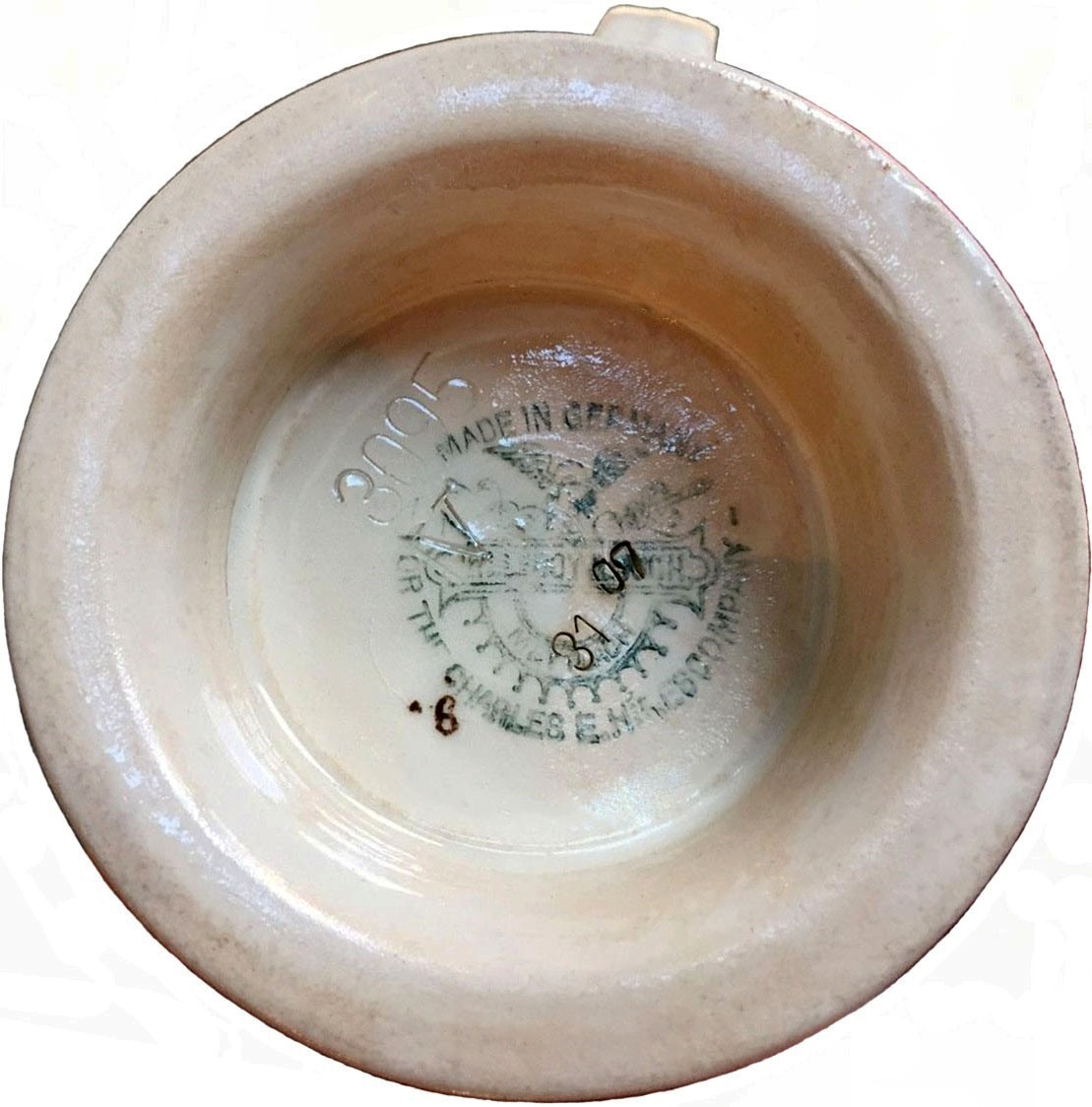
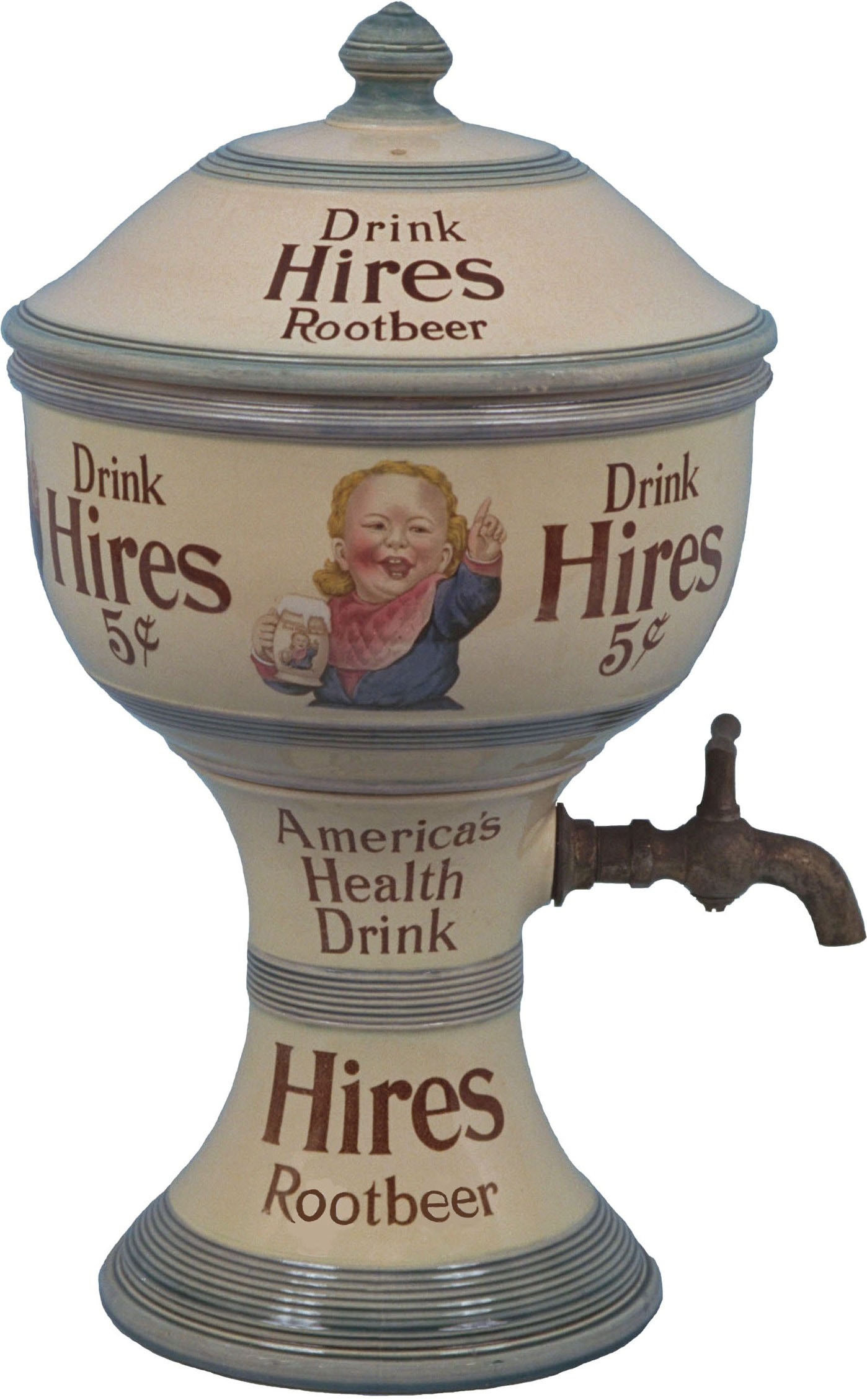
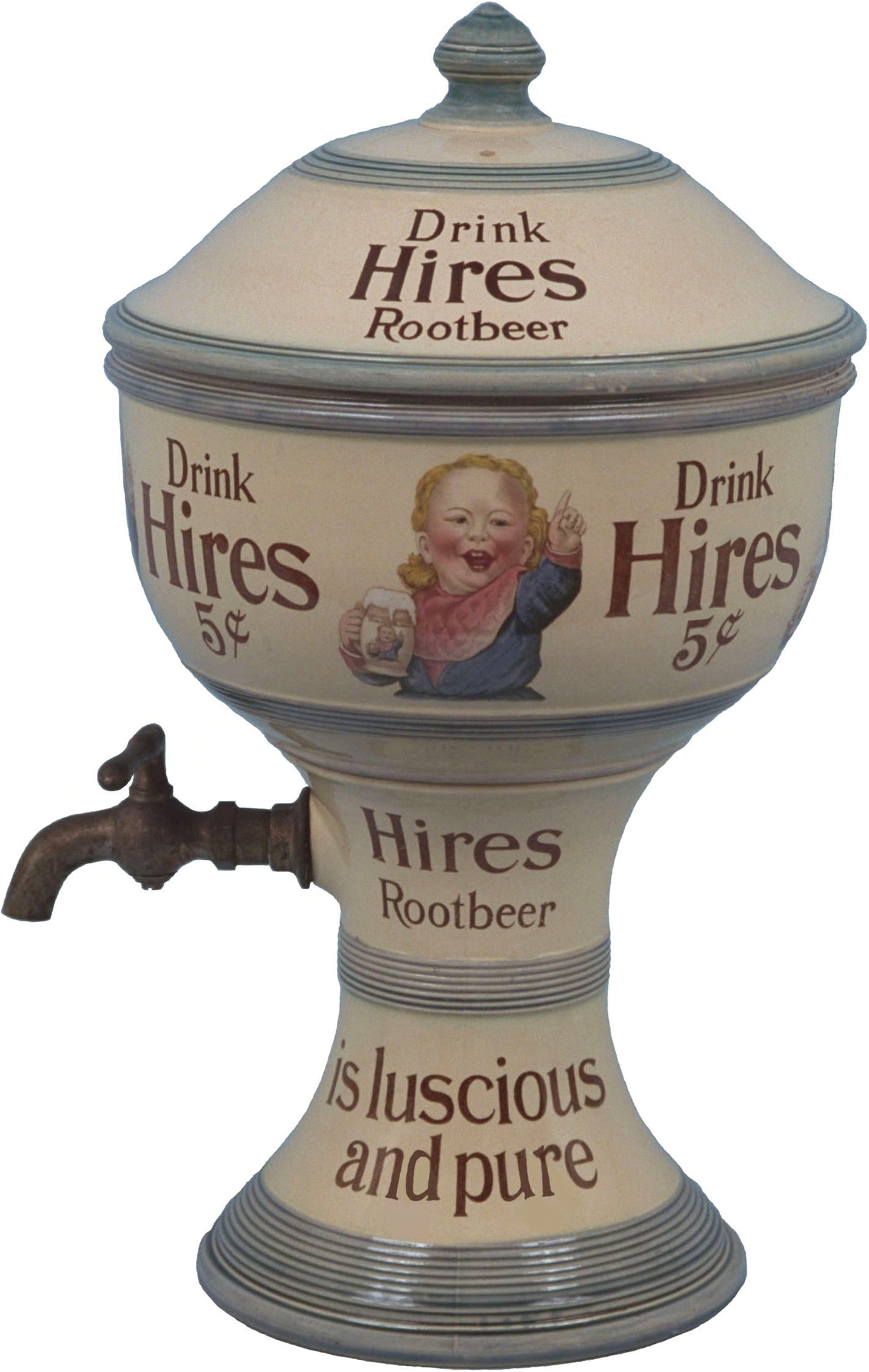

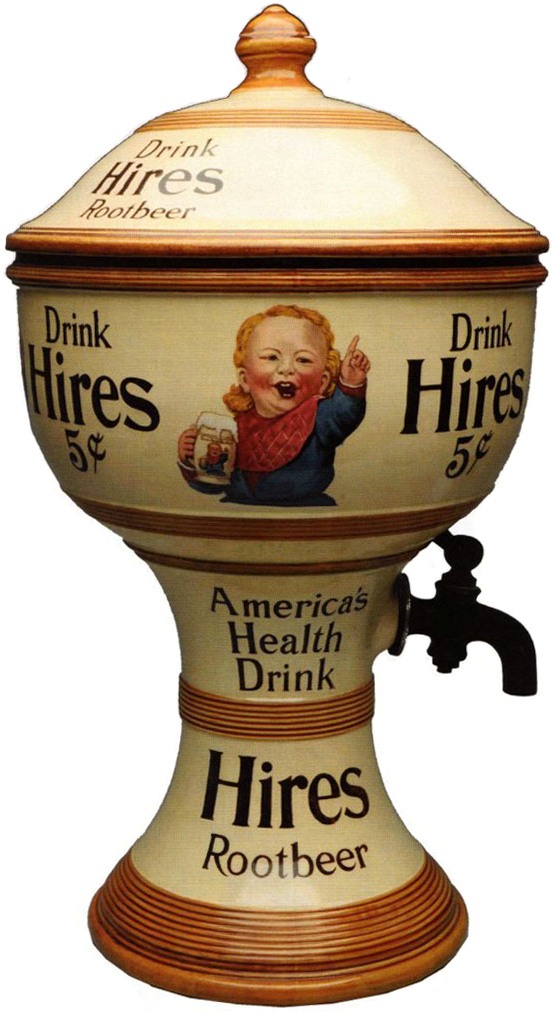
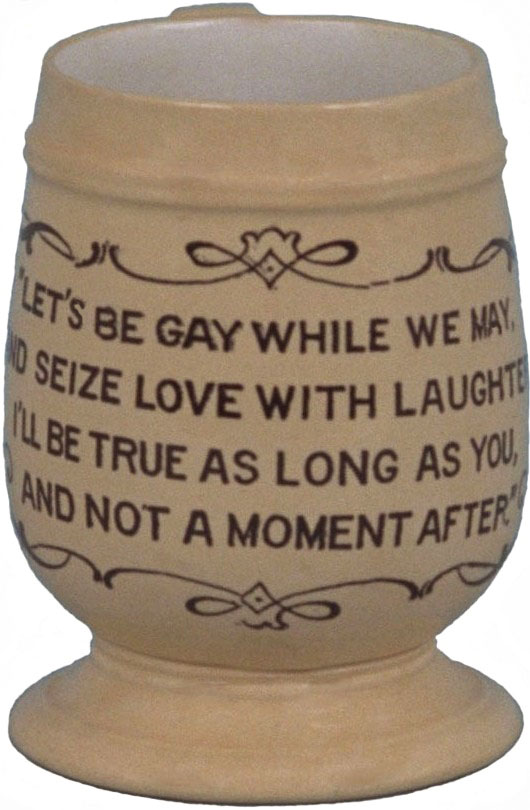

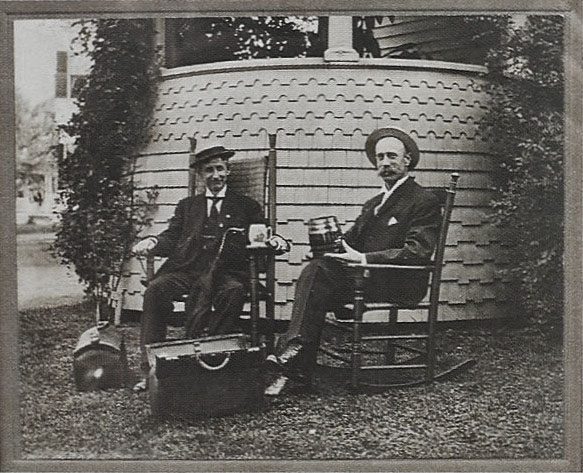

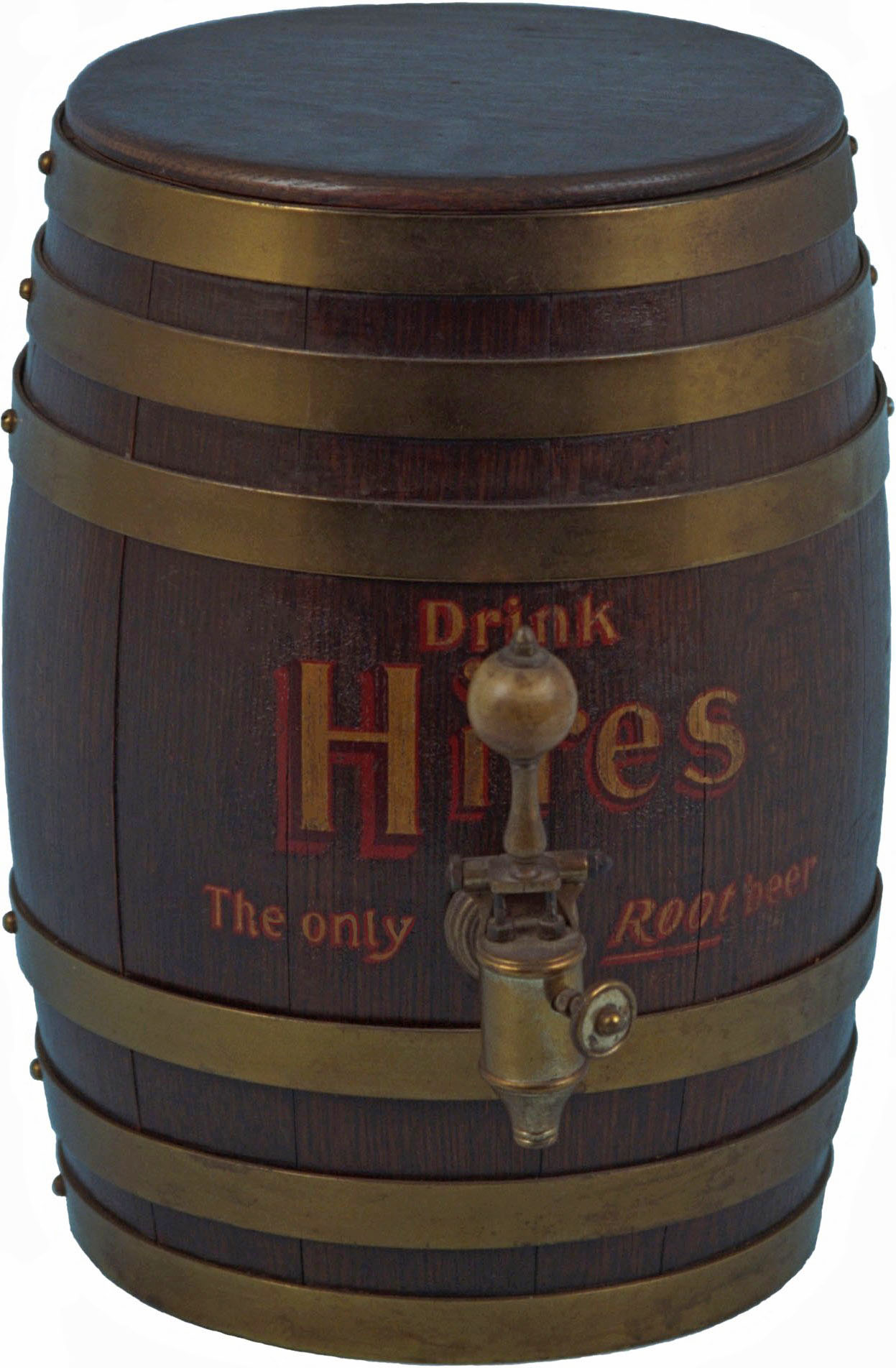





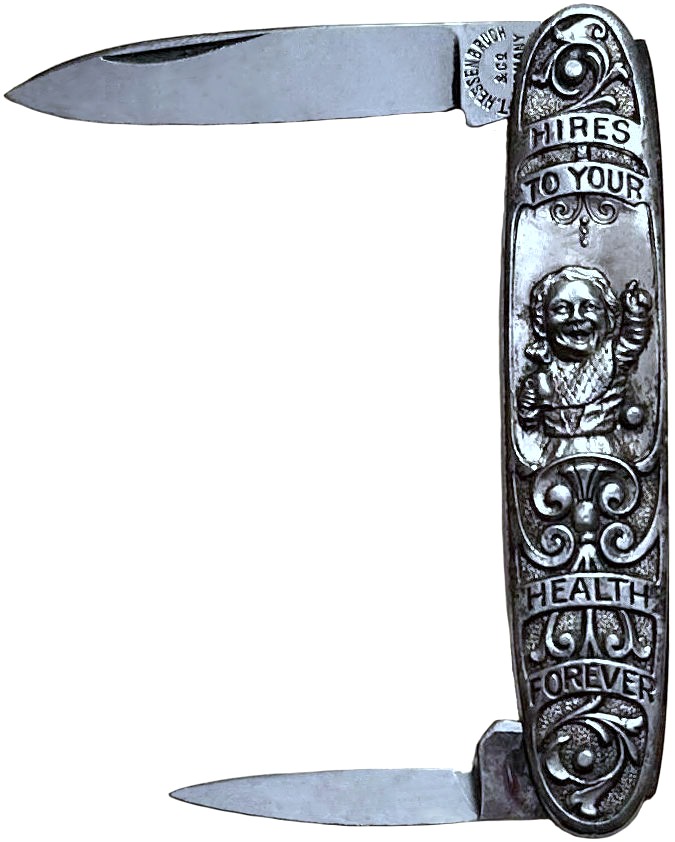
%20bottle%20image%20-%20metal%20pencil%20clip%20-%20Gustave%20Fox%20Co.,%20Cincinnati,%20OH%20-%20front.jpg)
%20bottle%20image%20-%20metal%20pencil%20clip%20-%20Gustave%20Fox%20Co.,%20Cincinnati,%20OH%20-%20back.jpg)

